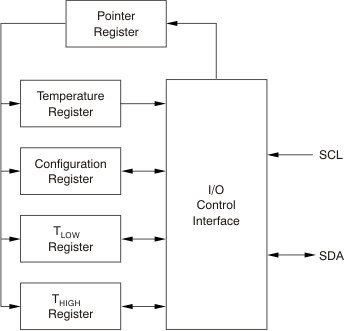SBOS397I August 2007 – June 2024 TMP102
PRODUCTION DATA
- 1
- 1 Features
- 2 Applications
- 3 Description
- 4 Pin Configuration and Functions
- 5 Specifications
-
6 Detailed Description
- 6.1 Overview
- 6.2 Functional Block Diagram
- 6.3 Feature Description
- 6.4 Device Functional Modes
- 6.5 Programming
- 7 Application and Implementation
- 8 Device and Documentation Support
- 9 Revision History
- 10Mechanical, Packaging, and Orderable Information
Package Options
Mechanical Data (Package|Pins)
- DRL|6
Thermal pad, mechanical data (Package|Pins)
Orderable Information
6.5.1 Pointer Register
Figure 6-6 illustrates the internal register structure of the TMP102 device. The 8-bit Pointer Register of the device is used to address a given data register. The Pointer Register uses the two least-significant bytes (LSBs) (see Table 6-15 and Table 6-16) to identify which of the data registers must respond to a read or write command. Table 6-6 identifies the bits of the Pointer Register byte. During a write command, P2 through P7 must always be '0'. Table 6-7 describes the pointer address of the registers available in the TMP102 device. The power-up reset value of P1 and P0 is 00. By default, the TMP102 device reads the temperature on power up.
 Figure 6-6 Internal Register Structure
Figure 6-6 Internal Register Structure| P7 | P6 | P5 | P4 | P3 | P2 | P1 | P0 |
|---|---|---|---|---|---|---|---|
| 0 | 0 | 0 | 0 | 0 | 0 | Register Bits | |
| P1 | P0 | REGISTER |
|---|---|---|
| 0 | 0 | Temperature Register (Read Only) |
| 0 | 1 | Configuration Register (Read/Write) |
| 1 | 0 | TLOW Register (Read/Write) |
| 1 | 1 | THIGH Register (Read/Write) |